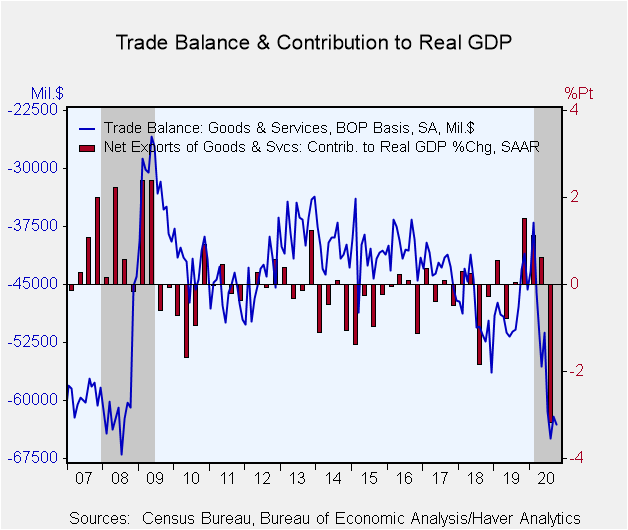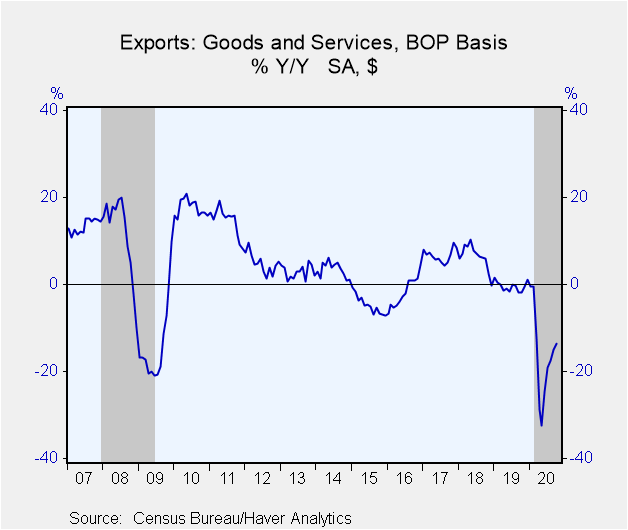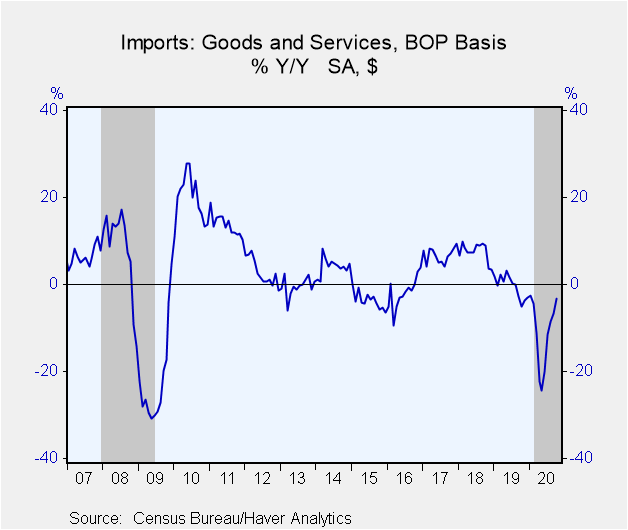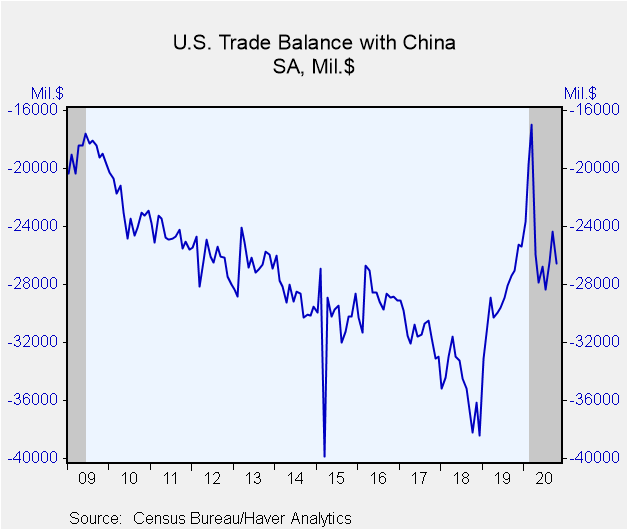 Global| Dec 04 2020
Global| Dec 04 2020U.S. Trade Deficit Widens in October as Exports Grow Faster than Imports
Summary
• Trade Deficit increases to $63.1 billion in October. • Exports grow 2.2%; Imports rise 2.1%. • Exports remain 13.2% below February level; imports down just 0.6%. The U.S. trade deficit in goods and services widened to $63.1 billion [...]
• Trade Deficit increases to $63.1 billion in October.
• Exports grow 2.2%; Imports rise 2.1%.
• Exports remain 13.2% below February level; imports down just 0.6%.
The U.S. trade deficit in goods and services widened to $63.1 billion in October from a downwardly-revised $62.1 billion in September (was $63.9 billion). August was also revised lower to $64.9 billion from $67.0 billion. The Action Economics Forecast Survey anticipated $65.0 billion. Exports gained 2.2% (-13.5% year-over-year), while imports increased 2.1% (-3,3% y/y). With these monthly gains exports remain 13.2% below February levels while imports are down just 0.6% (February 2020 was not the peak in both exports and imports, those occurred in 2018). The trade deficit cut 3.18 percentage points from Q3 GDP growth. Today's data suggest trade was less of a drag in Q3, but will continue to hamper growth in Q4.
The nominal deficit in goods trade increased to $81.4 billion in October from $80.8 billion. The advanced trade data reported last week had a $80.3 billion goods deficit. Exports of goods rose 3.0% (-7.3% y/y) as non-auto consumer goods were up 5.9% (-3.5% y/y). Imports of goods gained 2.3% (2.0% y/y) driven by a 3.2% gain in auto imports (10.2% y/y). Petroleum imports grew 2.9% (-37.2% y/y). Oil prices fell so volumes were up 7.5% in October (-3.1% y/y). Non-petroleum imports rose 2.3% (5.2% y/y). The real (inflation-adjusted) goods trade balance increased to $89.9 billion (chain-weighted 2012$) in October from $87.7 billion in September.
The surplus on trade in services declined to $18.3 billion from an upnwardly revised $18 7 billion (was $16.8 billion). The value of services exports grew 0.5% (-24.3% y/y) led by a 5.7% gain in travel (-74.6%). Imports of services gauned 1.9% (-24.4% y/y) also led by travel (18.9% month-on-month; -81.2% y/y). Services exports are still down 21.8% since February, while imports have fallen by 22.8% (the peaks in services trade occurred in 2019).
The politically-sensitive goods trade deficit with China widened to $26.5 billion in October from $24.3 billion. Exports and imports to China grew 9.3% and 9.1% respectively (68.4% and 13.9% y/y). Despite somewhat stronger growth in export, the deficit with China widened because imports are three times larger than exports. The trade deficit with the European Union narrowed to $15.7 billion while the imbalance with Japan ticked up to -$5.7 billion.
The international trade data, including relevant data on oil prices, can be found in Haver's USECON database. Detailed figures on international trade are available in the USINT database. The expectations figures are from the Action Economics Forecast Survey, which is carried in AS1REPNA.
| Foreign Trade in Goods & Services (Current $) | Oct | Sep | Aug | Oct Y/Y | 2019 | 2018 | 2017 |
|---|---|---|---|---|---|---|---|
| U.S. Trade Deficit ($ bil.) | 63.12 | 62.08 | 64.92 | 43.03 (10/19) |
576.86 | 579.94 | 513.79 |
| Exports of Goods & Services (% Chg) | 2.2 | 2.4 | 2.2 | -13.5 | -0.4 | 6.4 | 6.7 |
| Imports of Goods & Services (% Chg) | 2.1 | 0.6 | 3.2 | -3.3 | -0.5 | 7.5 | 6.7 |
| Petroleum (% Chg) | 2.9 | 0.1 | 14.4 | -37.3 | -14.0 | 20.8 | 27.2 |
| Nonpetroleum Goods (% Chg) | 2.3 | 0.0 | 2.8 | 5.2 | -0.4 | 7.4 | 5.5 |
Gerald D. Cohen
AuthorMore in Author Profile »Gerald Cohen provides strategic vision and leadership of the translational economic research and policy initiatives at the Kenan Institute of Private Enterprise.
He has worked in both the public and private sectors focusing on the intersection between financial markets and economic fundamentals. He was a Senior Economist at Haver Analytics from January 2019 to February 2021. During the Obama Administration Gerald was Deputy Assistant Secretary for Macroeconomic Analysis at the U.S. Department of Treasury where he helped formulate and evaluate the impact of policy proposals on the U.S. economy. Prior to Treasury, he co-managed a global macro fund at Ziff Brothers Investments.
Gerald holds a bachelor’s of science from the Massachusetts Institute of Technology and a Ph.D. in Economics from Harvard University and is a contributing author to 30-Second Money as well as a co-author of Political Cycles and the Macroeconomy.









